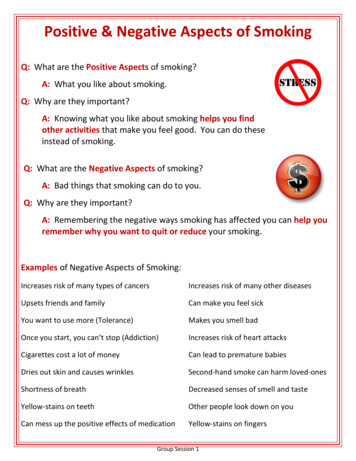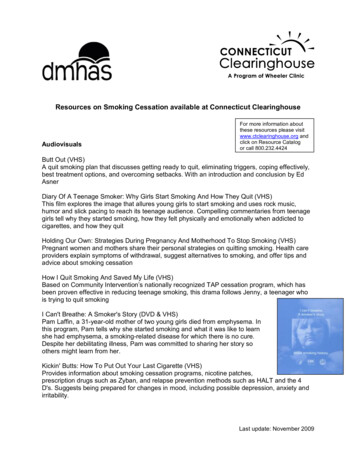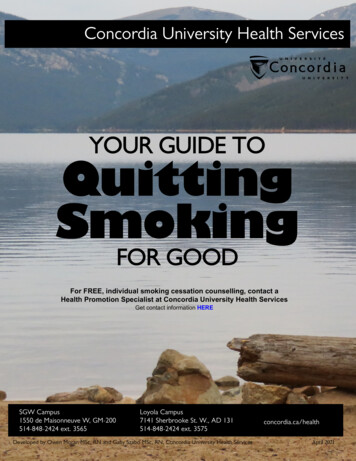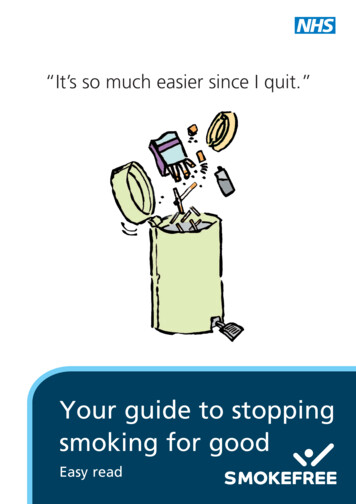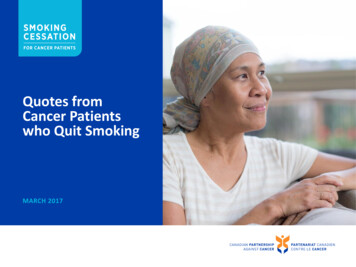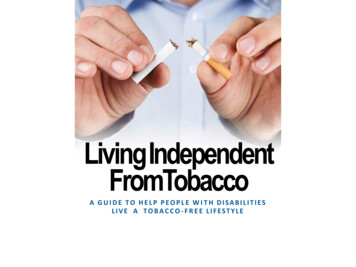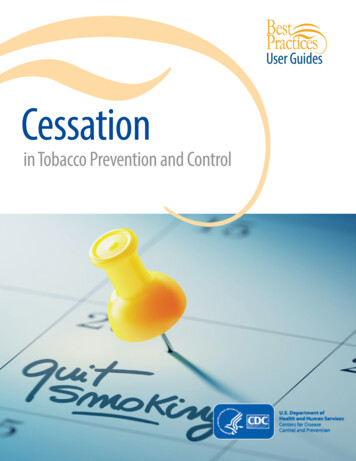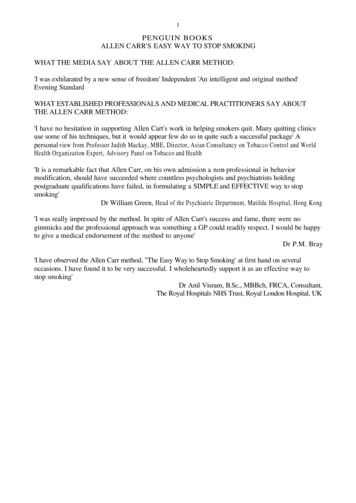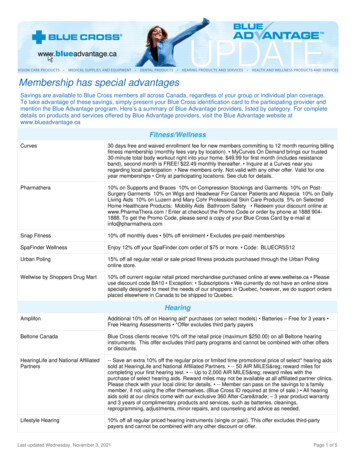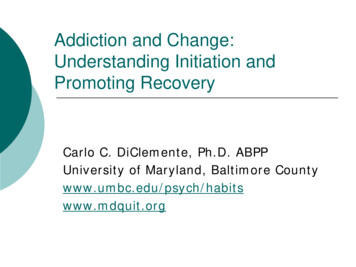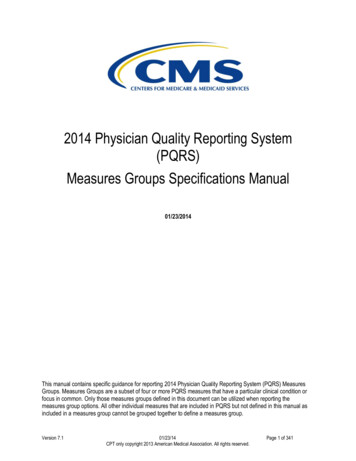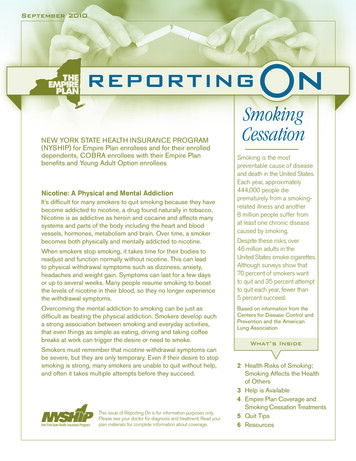
Transcription
September 2010NEW YORK STATE HEALTH INSURANCE PROGRAM(NYSHIP) for Empire Plan enrollees and for their enrolleddependents, COBRA enrollees with their Empire Planbenefits and Young Adult Option enrolleesNicotine: A Physical and Mental AddictionIt’s difficult for many smokers to quit smoking because they havebecome addicted to nicotine, a drug found naturally in tobacco.Nicotine is as addictive as heroin and cocaine and affects manysystems and parts of the body including the heart and bloodvessels, hormones, metabolism and brain. Over time, a smokerbecomes both physically and mentally addicted to nicotine.When smokers stop smoking, it takes time for their bodies toreadjust and function normally without nicotine. This can leadto physical withdrawal symptoms such as dizziness, anxiety,headaches and weight gain. Symptoms can last for a few daysor up to several weeks. Many people resume smoking to boostthe levels of nicotine in their blood, so they no longer experiencethe withdrawal symptoms.Overcoming the mental addiction to smoking can be just asdifficult as beating the physical addiction. Smokers develop sucha strong association between smoking and everyday activities,that even things as simple as eating, driving and taking coffeebreaks at work can trigger the desire or need to smoke.Smokers must remember that nicotine withdrawal symptoms canbe severe, but they are only temporary. Even if their desire to stopsmoking is strong, many smokers are unable to quit without help,and often it takes multiple attempts before they succeed.This issue of Reporting On is for information purposes only.Please see your doctor for diagnosis and treatment. Read yourplan materials for complete information about coverage.SmokingCessationSmoking is the mostpreventable cause of diseaseand death in the United States.Each year, approximately444,000 people dieprematurely from a smokingrelated illness and another8 million people suffer fromat least one chronic diseasecaused by smoking.Despite these risks, over46 million adults in theUnited States smoke cigarettes.Although surveys show that70 percent of smokers wantto quit and 35 percent attemptto quit each year, fewer than5 percent succeed.Based on information from theCenters for Disease Control andPrevention and the AmericanLung Association2 Health Risks of Smoking;Smoking Affects the Healthof Others3 Help is Available4 Empire Plan Coverage andSmoking Cessation Treatments5 Quit Tips6 Resources
Health Risks of SmokingChronic ObstructivePulmonary Disease (COPD)Smoking kills more Americansthan alcohol, car accidents, suicide,AIDS, homicide and illegal drugscombined. According to theAmerican Cancer Society, smokingcauses nearly one in five deaths inthe United States alone and is alsothe leading cause of many chronicdiseases and other illnesses. Stomach Pancreas Cervix Kidney BladderCancerPeople who smoke are morelikely to have heart attacks,high blood pressure, blood clots,strokes, hemorrhages, aneurysmsand other disorders of thecardiovascular system. In fact,one out of every five smokingrelated deaths is caused bycardiovascular disease. Smokersare two to four times more likelyto develop coronary heart disease(CHD), twice as likely to have astroke and ten times more likelyto develop peripheral vasculardisease (PVD) than nonsmokers.Smoking accounts for at least 30percent of all cancer deaths and islinked to nearly 90 percent of lungcancer deaths. Lung cancer is theleading cause of cancer death inboth men and women and remainsone of the hardest cancers to treat.Smoking is also linked to anincreased risk of the followingcancers: Larynx (voice box) Oral cavity (mouth, tongue and lips) Pharynx (throat) Esophagus (tube that connectsthe throat to the stomach)Based on information fromthe American Cancer SocietyCardiovascular DiseaseSmoking also increases aperson’s risk of developingchronic obstructive pulmonarydisease (COPD), a term used todescribe a group of lung diseasesthat blocks airflow and makesit increasingly difficult for thosesuffering from it to breathe. COPDis most commonly associated withemphysema and chronic bronchitis.It affects an estimated 32 millionpeople and is the fourth leadingcause of death in the United States.Based on information fromWomack Army Medical CenterBased on information from theUniversity of Virginia Health SystemSmoking Affects the Health of OthersSmoking not only has a negativeimpact on the health of smokers,but it can also harm those aroundthem. Secondhand smoke, thesmoke exhaled by a smoker oremitted from the burning end of alit cigarette, contains toxins thatcontribute to various healthproblems, from cardiovasculardisease to cancer.Dangers ofSecondhand SmokeThe dangerous particles insecondhand smoke can linger inthe air for hours. Breathing it fora short time can irritate your lungsand reduce the amount of oxygenin your blood.Prolonged or repeated exposureto secondhand smoke poses2RO Smoking Cessation/September 2010more significant health risks.The American Heart Associationestimates that approximately38,000 people die each year fromheart and blood vessel diseasecaused by secondhand smoke.It’s especially dangerous forchildren to be exposed tosecondhand smoke becausetheir lungs are smaller and notfully developed, which makes
Smoking Affects the Health of Others, continuedthem more vulnerable to thenegative effects. For example,children who live with smokersare more likely to develop middleear and lower respiratory tractinfections, as well as suffer fromchronic eye and nose irritation.Exposure to secondhand smokeduring pregnancy can be harmfulas well. According to the MayoClinic, secondhand smokeincreases the risk of having a babywith low birth weight and is linkedto a higher risk of sudden infantdeath syndrome (SIDS).Smoking during PregnancyWhen you smoke, you inhalepoisons such as nicotine andcarbon monoxide. When apregnant woman smokes, thesepoisons get into the placenta, thetissue that connects the motherto her baby. These poisons keepthe baby from getting the propersupply of nutrients and oxygenthat it needs to grow.Babies born to mothers who smokeare more likely to be premature andhave low birth weights, learningdisabilities and physical growthproblems, as well as chronic coldsand lung conditions.Help is AvailableSince nicotine causes bothmental and physical addiction,most people find the best way toquit smoking is a combination ofbehavioral management techniquesand medication. There are a widerange of counseling services,self-help materials and medicationsavailable today, so smokers havemore tools than ever before to helpthem quit smoking.The New York State Quitline isa free service offered by theNew York State Department ofHealth. Trained quit coachesprovide support, help callersdesign personalized quit plansand share information about localsmoking cessation programs.Taped support messages arealso available 24 hours a day,seven days a week.The New York State Quitline1-866-NY-QUITS(1-866-697-8487)Quit Programs, Counselingand Support GroupsTelephone counseling is one ofthe most convenient supportprograms available. It doesn’trequire driving, transportation orchild care, and it’s accessible24 hours a day, seven days aweek. According to the AmericanCancer Society, people who usetelephone counseling are twice aslikely to stop smoking as thosewho don’t get this type of help.Smoking cessation programs aredesigned to help smokersrecognize and cope with problemsthey face when they are trying toquit. They also offer emotionalsupport and encouragement.Studies have shown that the bestprograms include either one-on-oneor group counseling.Support groups for quitters canalso be helpful. For instance,Nicotine Anonymous is an open3RO Smoking Cessation/September 2010support group that offers a wayto find others who want to stopsmoking. Local branches of theAmerican Cancer Society,American Lung Association andhealth department often sponsorsmoking cessation classes, as well.Nicotine ReplacementTherapy (NRT)Nicotine replacement therapy(NRT) helps relieve some ofthe physical withdrawal symptoms,so smokers can focus on themental aspects of quitting. NRTprovides nicotine in the form ofgums, patches, sprays, inhalers orlozenges without the other harmfulchemicals found in tobacco.For more information aboutsmoking cessation programs,counseling, support groups andNRT, please contact your healthcare provider.
Empire Plan Coverage and Smoking Cessation TreatmentsTo help enrollees with the physicaladdiction to nicotine, below isinformation regarding nicotinereplacement therapies (NRT) andmedications used as an aid insmoking cessation. The Empire PlanPrescription Drug Program coverssmoking cessation treatments thatrequire a prescription, subject toapplicable copayments. Studieshave shown that pairing NRT and/or prescription medication withcounseling or help from a supportgroup can more than double one’schance of quitting permanently.Nasal SpraysNicotine nasal sprays delivernicotine into the nose where it isabsorbed into the bloodstream.It relieves withdrawal symptomsvery quickly and lets the userscontrol their nicotine cravings.Smokers usually like the nasalspray because it is easy to use.InhalersZyban The nicotine inhaler is a thinplastic tube with a nicotinecartridge inside. When the usertakes a puff from the inhaler, thecartridge puts out a nicotinevapor. Unlike other inhalers thatdeliver most of the medicine to thelungs, the nicotine inhaler deliversmost of the nicotine vapor to themouth. This treatment is a lot likesmoking a cigarette, which somesmokers find helpful.Zyban is a non-nicotineprescription medication. It actson chemicals in the brain that arerelated to nicotine craving. It canbe used alone or together withnicotine replacement therapy.Zyban works best if it is startedone or two weeks beforeattempting to quit smoking.PatchesThe nicotine patch provides asteady, controlled dose of nicotinethroughout the day, which helpsreduce the effects of nicotinewithdrawal. The strength of thepatch is reduced over time,allowing users to wean themselvesoff nicotine gradually. The patchshould be applied in the morningon a clean, dry area of the skinwithout much hair. It should beplaced below the neck andabove the waist, for example,on the upper arm or chest.Patches requiring a prescriptionare covered by The Empire Plan.However, most patches areavailable over the counter anddo not require a prescription.There are no Empire Plan benefitsfor over the counter drugs.4RO Smoking Cessation/September 2010Chantix Chantix is a prescription medicinethat helps people stop smokingby interfering with nicotinereceptors in the brain. It worksby lessening the pleasant effectsa person gets from smoking andreducing nicotine withdrawalsymptoms. It is recommendedto start taking Chantix one weekbefore attempting to quit smoking.Ask Your DoctorThere is no evidence that anyone type of smoking cessationmedication is more effective thananother. If you want to quitsmoking, talk with your doctorabout which prescription drug(s)would work best for you.Based on information from theAmerican Cancer Society
Quit TipsQuitting smoking is the mostimportant step that smokers cantake to enhance the length andquality of their lives. Quitting is noteasy, but it can be done. Nearly halfof all adult smokers have quit. Thereis no one right way to quit, but thereare key steps you can take that willincrease your likelihood of success:1. Make the decision to quitThe decision to quit smokingis one that only you can make.Others may want you to quit, butthe real commitment must comefrom you. Think about why youwant to quit and use thosereasons as motivators. Are you worried that you willget a smoking-related disease? Do you want to set a goodexample for your children? Do you want to protect yourfamily from the dangers ofsecondhand smoke? Do you need/want your moneyfor other things? Do you have a relative, spouse orfriend that developed a smokingrelated illness?2. Choose a Quit DayOnce you’ve decided to quit,choose a specific day within thenext month as your Quit Day. Giveyourself enough time to come upwith a plan and prepare. Circle thedate on your calendar, share it withyour family, friends and coworkers,and make a strong, personalpledge to quit on that day.3. Make a planSuccessful quitting is a matter ofplanning, preparation andcommitment, not luck. Decidenow on your own plan. If you’vetried to quit before, think backto your past attempts. Try toremember what worked for youand what didn’t. Think aboutwhat you could do differentlythis time. Consider using nicotinereplacement therapy, joining astop-smoking class, going toNicotine Anonymous meetingsor using a combination of thesemethods. Whatever method thatyou choose, plan, prepare andstay committed.4. PrepareHere are some steps to helpyou prepare for your Quit Day: Get rid of all the cigarettes,lighters and ashtrays in yourhome, car and workplace. Stock up on oral substitutes –sugarless gum, carrot sticks, hardcandy, cinnamon sticks, coffeestirrers, straws and/or toothpicks. Set up a support system. Thiscould be a group class, NicotineAnonymous, or a friend or familymember who wants to quit withyou or has successfully quit andis willing to help you. Plan activities for the first coupleof weeks following your Quit Dayto take your mind off smoking.Quitting will be easier if youkeep yourself busy.5. Follow throughYour Quit Day has arrived!What to do: Avoid places and situationswhere you normally smoke. Keep reminding yourself whyyou decided to quit and of allof the benefits of quitting. Call on your support systemfor help.5RO Smoking Cessation/September 2010 Remember that there will betimes when you will feel anxious,uneasy or unable to concentrate.This is normal, but will pass if youstay committed!Based on information from theAmerican Cancer SocietyRecovering from slipsIf you slip and start to smokeagain, don’t give up! Studies showthat it can take several attempts atquitting before a smoker is donewith smoking forever.Be patient with yourself and realizethat you are fighting a toughaddiction. Take this opportunity toreview what strategies have helpedyou during your smoke-free periodand what has not, and then makeadjustments.Do not put off quitting, becauseif you get back into the habit ofsmoking, your body will get usedto the nicotine again.The following checklist outlineswhat to do if you find yourselfsmoking again:1. Get rid of any cigarettes.2. Think of that first cigarette as a“slip” rather than a “relapse.”3. Do not feel bad and give up.4. Use behavioral and mentalcoping skills. (Leave thesituation, call a friend, and/orlist your reasons for quitting.)5. Commit to quitting againright away.6. Learn from your slip. Be betterprepared next time.Based on information produced by theTobacco Research and InterventionProgram at the H. Lee Moffitt CancerCenter & Research Institute at theUniversity of South Florida
ResourcesAmerican Heart Association1-800-242-8721www.heart.orgAmerican Stroke American Lung Association1-800-548-8252www.lungusa.orgCenters for Disease Controland Prevention: Smoking andTobacco Use1-800-232-4636www.cdc.gov/tobaccoNational Cancer Institute1-800-422-6237www.cancer.govNicotine ew York State Smokers’ QuitlineNY Residents:1-866-NY-QUITS(1-866-697-8487)for free assistancewww.nysmokefree.comNorth AmericanQuitline ConsortiumResidents of other e.netState of New York Department of Civil Service, Employee Benefits Division, Albany, New York 12239 https://www.cs.state.ny.usIt is the policy of the State of New York Department of Civil Service to provide reasonable accommodation to ensure effective communication of information inbenefits publications to individuals with disabilities. These publications are also available on the Department of Civil Service web site (https://www.cs.state.ny.us).Check the web site for timely information that meets universal accessibility standards adopted by New York State for NYS Agency web sites. If you needan auxiliary aid or service to make benefits information available to you, please contact your agency Health Benefits Administrator. NYS and PE Retirees,NYS and PE COBRA Enrollees and Young Adult Enrollees: Contact the Employee Benefits Division at (518) 457-5754 (Albany area) or 1-800-833-4344(U.S., Canada, Puerto Rico, Virgin Islands).This Report was printed using recycled paper and environmentally sensitive inks.6AL0970RO Smoking Cessation/September 2010RO Smoking Cessation/September 2010
most people find the best way to quit smoking is a combination of behavioral management techniques and medication. There are a wide range of counseling services, self-help materials and medications available today, so smokers have more tools than ever before to help them quit smoking. Th
